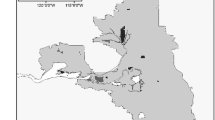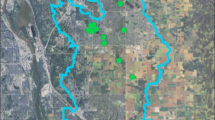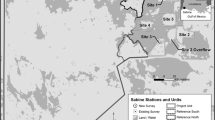Abstract
One critical component of any wetland restoration program is reliably documenting temporal changes in the spatial extent, pattern, and proportion of plant communities within the landscape. This study describes the development of a 2003 baseline vegetation map for a 42,635 ha wetland impoundment located in the northern portion of the remnant Everglades, Florida. Vegetation communities were photointerpreted and mapped with a 1/4 ha minimum mapping grid unit from 1:24,000 scale color infrared aerial photography utilizing 1st order analytical stereo-plotters. Results show an impoundment that has significantly changed in comparison to an earlier 1940s mapping effort. These included the loss of most of the tree island habitat and the establishment of large expanses of invasive cattail adjacent to and downstream of inflow structures with 28% of the grid cells containing cattail. Our techniques will be very useful in evaluating Everglade’s restoration and are applicable to wetlands around the world.
Similar content being viewed by others
Literature Cited
Adorisio, C., C. Bedregal, S. Daroubl, J. DeLeon, M. Edwards, C. Garvey, J. Madden, P. McGinnes, C. Miessau, D. Pescatore, P. Sievers, S. Van Horn, T. van Veen, J. Vega, S. K. Xue, and H. Zhao. 2006. Chapter 3: phosphorus controls for the basins tributary to the Everglades protection area. p. 31–389. In 2006 South Florida Environmental Report. South Florida Water Management District, West Palm Beach, FL, USA.
Alexander, T. R. and A. G. Crook. 1975. Recent and long term vegetation changes and patterns in south Florida. south Florida ecological study, University of Miami, Coral Gables, FL, USA. Part II. PB-264-462.
Burns, C. S. and R. E. McDonnell. 2003. Everglades protection area tributary basins long-term plan for achieving water quality goals. Report prepared for South Florida Water Management District, West Palm Beach, FL, USA.
Cooper, R. M. and J. Roy. 1991. An atlas of surface water management basins in the Everglades: The Water Conservation Areas and Everglades National Park. South Florida Water Management District, West Palm Beach, FL, USA. Memorandum DRE-300.
Davis, J. H., Jr. 1943. The natural features of southern Florida. Florida Geological Survey Bulletin 25, Tallahassee, FL, USA.
Davis, S. M. 1991. Growth, decomposition, and nutrient retention of Cladium jamaicense Crantz and Typha domingensis Pers. in the Florida Everglades. Aquatic Botany 40: 203–24.
Davis, S. M. 1994. Phosphorus inputs and vegetation sensitivity in the Everglades. p. 357–78. In S. M. Davis and J. C. Ogden (eds.) Everglades, The Ecosystem and its Restoration. St. Lucie Press, Delray Beach, FL, USA.
Davis, S. M., L. H. Gunderson, W. A. Park, J. R. Richardson, and J. E. Mattson. 1994. Landscape dimension, composition, and function in a changing Everglades ecosystem. p. 419–44. In S. M. Davis and J. C. Ogden (eds.) Everglades, The Ecosystem and its Restoration. St. Lucie Press, Delray Beach, FL, USA.
Dineen, J. W. 1972. Life in the tenacious Everglades. South Florida Water Management District, West Palm Beach, FL, USA. In Depth Report (5).
Dineen, J. W. 1974. Examination of water management alternatives in Conservation Area 2A. South Florida Water Management District, West Palm Beach, FL, USA. In Depth Report 2 (3).
Doren, R. F., T. V. Armentano, L. D. Whiteaker, and R. D. Jones. 1997. Marsh vegetation patterns and soil phosphorus gradients in the Everglades ecosystem. Aquatic Botany 56: 145–63.
Douglas, M. S. 1947. The Everglades River of Grass. Rinehart, New York, NY, USA.
Falkner, E. 1995. Aerial Mapping: Methods and Applications. CRC Press, Boca Raton, FL, USA.
Gawlik, D. E., P. Gronmeyer, and R. A. Powell. 2002. Habitatuse patterns of avian seed dispersers in the central Everglades. p. 445–68. In F. H. Sklar and A. van der Valk (eds.) Tree Islands of the Everglades. Kluwer Academic Publishers, Boston, MA, USA.
Harper, R. M. 1927. Natural resources of southern Florida. p. 25–206. In Eighteenth Annual Report of Florida Geological Survey. Tallahassee, FL, USA.
Harshberger, J. W. 1914. The vegetation of south Florida. Trans Wagner Free Institute of Science Philosophy 3: 51–189.
Hinsken, L. 2002a. Orima orientation management software users guide. Leica-Geosystems, Heerbrugg, Switzerland.
Hinsken, L. 2002b. Combined adjustment program (CAP-A): aerial version users guide. Leica-Geosystems, Heerbrugg, Switzerland.
Jensen, J., K. Rutchey, M. Koch, and S. Narumalani. 1995. Inland wetland change detection in the Everglades Water Conservation Area 2A using a time series of normalized remotely sensed data. Journal of Photogrammetric Engineering and Remote Sensing 61: 199–209.
Jensen, J. R. 2005. Introductory Digital Image Processing: A Remote Sensing Perspective. Pearson Prentice Hall, Upper Saddle River, NJ, USA.
Light, S. S. and J. W. Dineen. 1994. Water control in the Everglades: a historical perspective. p. 47–84. In S. M. Davis and J. C. Ogden (eds.) Everglades, The Ecosystem and its Restoration. St. Lucie Press, Delray Beach, FL, USA.
Lillesand, T. M. and R. W. Kiefer. 1987. Remote Sensing and Image Processing. John Wiley & Sons, Inc., New York, NY, USA.
Loveless, C. M. 1959. A study of vegetation in the Florida Everglades. Ecology 40: 1–9.
Ma, Z. and L. Redmond. 1995. Tau coefficients of accuracy assessment of classification of remote sensing data. Journal of Photogrammetric Engineering and Remote Sensing 61: 435–39.
Miao, S. L. and W. F. DeBusk. 1999. Effects of phosphorus enrichment on structure and function of sawgrass and cattail communities in Florida Everglades. p. 275–99. In K. R. Reddy, G. A. O’Conner, and C. L. Shelske (eds.) Phosphorus Biogeochemistry in Subtropical Ecosystems. CRC Press/Lewis Publishers, Boca Raton, FL, USA.
Newman, S., J. B. Grace, and J. W. Koebel. 1996. Effects of nutrients and hydroperiod on Typha, Cladium, and Eleocharis: implications for Everglades restoration. Ecological Applications 6: 774–83.
RECOVER. 2004a. RECOVER program management plan. Restoration Coordination and Verification (RECOVER), South Florida Water Management District, West Palm Beach, FL, USA and United States Army Corps of Engineers, Jacksonville, FL, USA.
RECOVER. 2004b. CERP monitoring and assessment plan: Part 1 monitoring and supporting research. Restoration Coordination and Verification (RECOVER), United States Army Corps of Engineers, Jacksonville, FL, USA and South Florida Water Management District, West Palm Beach, FL, USA.
Rutchey, K., T. N. Schall, R. F. Doren, A. Atkinson, M. S. Ross, D. T. Jones, M. Madden, L. Vilchek, K. A. Bradley, J. R. Snyder, J. N. Burch, T. Pernas, B. Witcher, M. Pyne, R. White, T. J. SmithIII, J. Sadie, C. S. Smith, M. E. Patterson, and G. D. Gann. 2006. Vegetation classification for south Florida natural areas. United States Geological Survey, Saint Petersburg, FL, USA. Open-File Report 2006-1240.
Rutchey, K. and L. Vilchek. 1994. Development of an Everglades vegetation map using a SPOT image and the global positioning system. Photogrammetric Engineering and Remote Sensing 60: 767–75.
Rutchey, K. and L. Vilchek. 1999. Air photo-interpretation and satellite imagery analysis techniques for mapping cattail coverage in a northern Everglades impoundment. Photogrammetric Engineering and Remote Sensing 65: 185–91.
Simberloff, D., D. C. Schmitz, and T. C. Brown. 1997. Strangers in Paradise. Island Press, Washington, DC, USA.
Sklar, F. H., C. McVoy, R. ZanZee, D. E. Gawlik, K. Tarboton, D. Rudnick, S. Miao, and T. Armentano. 2002. The effects of altered hydrology on the Everglades. p. 39–82. In J. W. Porter and K. G. Porter (eds.) The Everglades, Florida Bay and Coral Reefs of the Florida Keys: An Ecosystem Sourcebook. CRC Press, Boca Raton, FL, USA.
Sklar, F. H. and A. van der Valk. 2002. Tree Islands of the Everglades. Kluwer Academic Publishers, Boston, MA, USA.
Snedecor, G. W. and W. G. Cochran. 1978. Statistical Methods, sixth edition. Iowa State University, Ames, IA, USA.
USACE. 1996. Master water control manual for Water Conservation Areas, Everglades National Park and ENP-south Dade conveyance system, Volume 4. U.S. Army Corps of Engineers, Jacksonville, FL, USA.
U.S. Congress. 2000. Section 601 of the Water Resources Development Act of 2000. Washington DC, USA. Public Law 106-541.
Volin, J. C., M. S. Lott, J. D. Muss, and D. Owen. 2004. Predicting rapid invasion of the Florida Everglades by Old World Climbing Fern (Lygodium microphyllum). Diversity and Distributions 10: 439–46.
Willoughby, H. L. 1898. Across the Everglades, A Canoe Journey of Exploration. J. M. Dent and Company, London, England.
Worth, D. F. 1988. Environmental response of WCA-2A to reduction in regulation schedule and marsh drawdown. South Florida Water Management District, West Palm Beach, FL, USA. Technical Publication DRE-250.
Wu, Y., K. Rutchey, W. Guan, L. Vilchek, and F. H. Sklar. 2002. Spatial simulations of tree islands for Everglades restoration, p. 469–98. In F. H. Sklar and A. van der Valk (eds.) Tree Islands of the Everglades. Kluwer Academic Publishers, Boston, MA, USA.
Author information
Authors and Affiliations
Rights and permissions
About this article
Cite this article
Rutchey, K., Schall, T. & Sklar, F. Development of vegetation maps for assessing Everglades restoration progress. Wetlands 28, 806–816 (2008). https://doi.org/10.1672/07-212.1
Received:
Accepted:
Issue Date:
DOI: https://doi.org/10.1672/07-212.1




